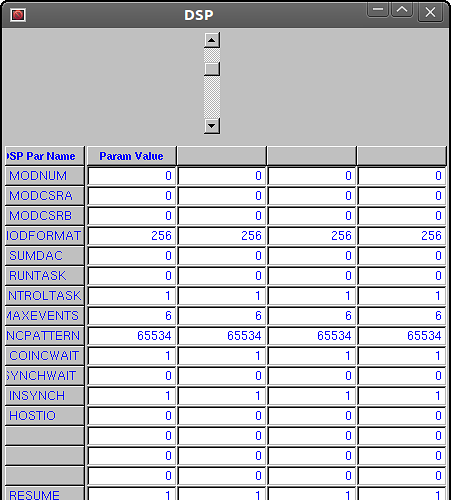Hi,
I have many (> 400) user parameters that I read into an instance of the class Table inherited from the (public) class TGTransientFrame (below). As only a subset of the 400 user parameters simultaneously fit onto the screen I have been trying to add a vertical scroll bar to access (show) those “hidden” parameters. The screen shot I attach illustrates the relative futility of my attempts. Surely this is not an unusual situation, but I am unable to find a remotely similar post.
Thanks,
Steve Asztalos
Table::Table (const TGWindow * p, const TGWindow * main, int columns,
int rows, char *name, int NumModules)
{
SetCleanup (kDeepCleanup);
//Rows=rows;
numModules=NumModules;
mn_vert = new TGVerticalFrame (this, 200, 300);
//TGMainFrame *fMainFrame1101 = new TGMainFrame(0,10,10,kMainFrame | kVerticalFrame);
//fMainFrame1101->SetLayoutBroken(kTRUE);
TGVScrollBar *fVScrollBar = new TGVScrollBar(mn_vert,16,102,kVerticalFrame | kOwnBackground);
fVScrollBar->SetRange(100,20);
fVScrollBar->SetPosition(21);
mn_vert->AddFrame(fVScrollBar, new TGLayoutHints(kLHintsLeft | kLHintsTop,200,2,2,2));
fVScrollBar->MoveResize(168,128,16,102);
// mn_vert->SetMWMHints(kMWMDecorAll,
// kMWMFuncAll,
// kMWMInputModeless);
mn_vert->MapSubwindows();
mn_vert->Resize(mn_vert->GetDefaultSize());
mn_vert->MapWindow();
mn_vert->Resize(490,370);
mn = new TGHorizontalFrame (mn_vert, 200, 300);
//TGMainFrame *fMainFrame1101 = new TGMainFrame(0,10,10,kMainFrame | kVerticalFrame);
//fMainFrame1101->SetLayoutBroken(kTRUE);
TGHScrollBar *fHScrollBar = new TGHScrollBar(mn,16,102,kHorizontalFrame | kOwnBackground);
fHScrollBar->SetRange(100,20);
fHScrollBar->SetPosition(21);
mn->AddFrame(fHScrollBar, new TGLayoutHints(kLHintsLeft | kLHintsTop,200,2,2,2));
fHScrollBar->MoveResize(168,128,16,102);
mn_vert->AddFrame (mn,
new TGLayoutHints (kLHintsTop | kLHintsLeft, 0, 0, 0,
0));
AddFrame (mn_vert,
new TGLayoutHints (kLHintsTop | kLHintsLeft, 2, 2, 2, 2));
Buttons = new TGHorizontalFrame (mn_vert, 400, 300);
Column = new TGVerticalFrame *[columns];
for (int i = 0; i < columns; i++)
{
Column[i] = new TGVerticalFrame (mn, 200, 300);
mn->AddFrame (Column[i],
new TGLayoutHints (kLHintsTop | kLHintsLeft, 0, 0, 0, 0));
}
…
…
…
}
